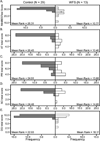Balance impairment in individuals with Wolfram syndrome
- PMID: 22771154
- PMCID: PMC3417287
- DOI: 10.1016/j.gaitpost.2012.06.008
Balance impairment in individuals with Wolfram syndrome
Abstract
Aim: Wolfram syndrome (WFS), a rare neurodegenerative disorder, is characterized by early onset insulin-dependent diabetes mellitus, optic atrophy, deafness, diabetes insipidus, and neurological abnormalities. Although previously unreported, we hypothesized that neurological complications may be detectable in relatively early stages of the disease. As the cerebellum and brainstem seem particularly vulnerable in WFS, we focused on balance functions critically dependent on these regions. The primary goal of this investigation was to compare balance in young individuals with WFS, in relatively early stages of the disease, to an age-matched cohort using a clinically applicable test.
Method: Balance was assessed via the mini-BESTest in 13 children, adolescents and young adults with WFS and 30 typically developing age-matched individuals.
Results: A significant difference was observed between groups in balance as well as in three of four subcomponents of the mini-BESTest and in two timed tasks related to balance. Mini-BESTest scores were correlated with age among typically developing individuals. In the WFS group, mini-BESTest scores were related to overall motor dysfunction, but not age.
Interpretation: Impairments in balance in WFS may occur earlier in the disease process than previously recognized and appear to be related to overall neurological progression rather than chronological age. Recognizing balance impairments and understanding which balance systems contribute to balance deficits in those with WFS may allow for development of effective patient-centered treatment paradigms.
Copyright © 2012 Elsevier B.V. All rights reserved.
Conflict of interest statement
The authors declare that they have no conflicts of interest and all funding sources have been disclosed above.
Figures



References
-
- Barrett TG, Bundey SE, Macleod AF. Neurodegeneration and diabetes: Uk nationwide study of wolfram (didmoad) syndrome. Lancet. 1995;346:1458–1463. - PubMed
-
- Barrett TG, Bundey SE, Fielder AR, Good PA. Optic atrophy in wolfram (didmoad) syndrome. Eye (Lond) 1997;11(Pt 6):882–888. - PubMed
-
- Kinsley BT, Swift M, Dumont RH, Swift RG. Morbidity and mortality in the wolfram syndrome. Diabetes Care. 1995;18:1566–1570. - PubMed
-
- Lombardo F, Chiurazzi P, Hortnagel K, Arrigo T, Valenzise M, Meitinger T, Messina MF, Salzano G, Barberi I, De Luca F. Clinical picture, evolution and peculiar molecular findings in a very large pedigree with wolfram syndrome. J Pediatr Endocrinol Metab. 2005;18:1391–1397. - PubMed
Publication types
MeSH terms
Grants and funding
- T32 NS051171-04/NS/NINDS NIH HHS/United States
- R37 DK016746/DK/NIDDK NIH HHS/United States
- T32 NS051171/NS/NINDS NIH HHS/United States
- UL1 RR024992/RR/NCRR NIH HHS/United States
- T32 HD007434/HD/NICHD NIH HHS/United States
- S10 RR022984/RR/NCRR NIH HHS/United States
- 1S10RR022984-01A1/RR/NCRR NIH HHS/United States
- R01 HD070855/HD/NICHD NIH HHS/United States
- UL1 TR000448/TR/NCATS NIH HHS/United States
- DK016746-39/DK/NIDDK NIH HHS/United States
- R01 DK016746/DK/NIDDK NIH HHS/United States
- 2T32 HD007434-18/HD/NICHD NIH HHS/United States
LinkOut - more resources
Full Text Sources
Research Materials

